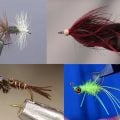How to Tie a Matt’s Midge
Producer: Tim Flagler
Tier and videographer Tim Flagler: “Matt’s Midge is named for its originator, Matt Miles of Colorado. I believe he developed this pattern with western tailwaters in mind, but here in the East it works exceptionally well, particularly during the winter months.
Matt’s Midge is named for its originator, Matt Miles of Colorado. I believe he developed this pattern with western tailwaters in mind, but here in the East it works exceptionally well, particularly during the winter months.
For a hook, I’m going to use a Dai-Riki #310 in size 22. Ring or straight eye hooks just seem to look right with midge patterns. As always, plunger-style hackle pliers make handling small hooks like this much easier. Fine needle-nosed pliers are great for mashing the barb and should have a place in every fly tier’s kit. With the barb mashed, get the hook firmly secured in the jaws of your tying vise.
For thread, I’ve loaded a bobbin with a spool of black 6/0 Danville which, despite its relatively thick diameter, works remarkably well on small flies.
Start your thread on the hook shank leaving a very full eye-length space behind the eye and take a few wraps rearward before snipping or breaking off the tag. Continue taking thread wraps rearward all the way to the start of the hook bend, followed by touching wraps up the shank to create the body of the fly. End with your thread a bit forward of the midpoint on the hook shank.
For the fly’s delicate emergent wing, I’m going to use white Zelon but Antron or EP Trigger Point Fibers will also work just fine. After snipping a single strand free from the hank, I’ll split it in two as you don’t want the wing to be too heavy. To save the second half of the strand for later use, give one end a little twist and store it in the hook of plunger-style hackle pliers to keep it from getting lost on your tying bench. Pick up one end of the other half of the Zelon strand. Lay this end against the near side of the hook, and starting with a pinch wrap, begin securing it to the top of the shank with tight turns of tying thread. Once it’s locked down really well, lift the short butt ends up to vertical and snip them off close, then cover them with nice even wraps of tying thread. While pulling the Zelon taught rearward, snip it off to form a short wing that extends roughly to the back edge of the body.
To hackle the fly, I’m going to use a single feather from a rooster saddle. Check to make sure you have the correct length, here, a near perfect size 22, before plucking the feather free from the stem. With the shiny side of the feather facing you, pull down a half inch or so, of the lower fibers, perpendicular to the stem. Relocate your tying thread back to the base of the wing, all the while trying to keep this area flat and smooth. Lay the intersection of the different angled hackle fibers against the near side of the hook and take a few thread wraps to anchor the stem. You can then pull the excess stem back and snip it off close. If you’ve trapped any hackle fibers in the process, now’s a good time to snip off the wayward ones. Make sure your thread is positioned right up behind the hook eye.
Get hold of the hackle feather and start making touching wraps forward up the shank. When you reach your tying thread, use it to secure the hackle stem immediately behind the hook eye. You can then snip the excess hackle off close and save it for later use. Finally, secure your tying thread with a 3 or 4 turn whip finish and, after seating the knot well, snip or cut the thread free.
Matt’s Midge, despite its small size, is not too difficult to tie and a pattern that should be in every flyfisher’s midge box.”
How to Tie a Matt's Gnat
How to Tie a Matt's Monster Bugger











